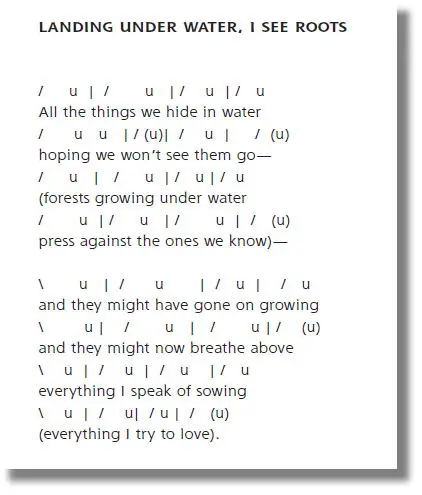


( It would be confusing at best to literate an entire poem consisting of purely spondaic feet -it would sound like a drill! Or Incessant hammering! For this reason, the spondee is usually used for emphasis, or to break up another foot such as the anapest.)Īnd the | QUAINT MAZ | es in | the WAN | ton GREEN.Shall I | comPARE | thee TO | a SUM | mer’s DAY? |ĭOUble, | DOUble, | TOIL and | TROUble - |Įxamples: AMEN // ARCH-FIEND // DARK NIGHT To begin to look at graphic scansion, we first must look at a couple of symbols that are used to scan a poem.They brought a woman from the street And made her sit in the stalls By threats By bribes By flattery Obliging her to share a little of her life with actors But I don't understand art Sit still, they said But I don't want to see sad things Sit still, they said And she listened to everything Understanding some things But not others Laughing rarely, and always without knowing why Sometimes suffering disgust Sometimes thoroughly amazed And in the light again, said If that's art I think it is hard work It was beyond me So much beyond my actual life But something troubled her Something gnawed her peace And she came a second time, armoured with friends Sit still, she said And again, she listened to everything This time understanding different things This time untroubled that some things Could not be understood Laughing rarely but now without shame Sometimes suffering disgust Sometimes thoroughly amazed And in the light again said This is art, it is hard work And one friend said, too hard for me And the other said, if you will I will come again Because I found it hard I felt honoured - Howard Barker, from The Bite of the Night For a discussion of the others, I refer you to Fussell, page 18. Since the most commonly and most easily used is graphic, we will use it in our discussion. There are three kinds of scansion: the graphic, the musical and the acoustic. This technique is called scansion, and it is important because it puts visual markers onto an otherwise entirely heard phenomenon. To get a bearing on what these rhythms look and sound like, let's start with a method for writing out the rhythms of a poem. The former is the more common adherence to the latter often leads an English language poet toward self-conscious verse, as their predictable rhythms are counter to natural English speech (not that it is impossible to create great verse with this technique, but there is a tendency for it to end up so). For this reason most English language poets opt to look at their own meter as accentual or accentual-syllabic. There may be one, two, or three syllables between accents (or more, but this is a matter of debate). This means that its natural rhythms are not found naturally from syllable to syllable, but rather from one accent to the next. English, being of Germanic origin, is a predominantly accentual language. Of the ways of looking at meter, the most common in English are those that are accentual. Quantitative: Measures the duration of words.


Accentual-syllabic: A counting of syllables and accents.Accentual: A counting of accents only per line.Syllabic: A general counting of syllables per line.Fussell defines meter as "what results when the natural rhythmical movements of colloquial speech are heightened, organized, and regulated so that emerges from the relative phonetic haphazard of ordinary utterance." (4-5) To "meter" something, then, is to "measure" it (the word meter itself is derived from the Greek for measure), and there are four common ways to view meter. Although some of Fussell's ideas are a bit outdated (namely, he doesn't deal with the visual elements of a poem), his approach is complete, concise and useful. The bible of most poets today regarding meter and sound is a book by Paul Fussell called Poetic Meter and Poetic Form. The crafting of the aural aspects of a poem is what we may call "ear training." Thus, the crafting of the visual aspects is what we'd call "eye training." Meter Writing Letters of Recommendation for StudentsĪ brief exploration of the various aspects of sound that can be utilized when making a poem.


 0 kommentar(er)
0 kommentar(er)
